LOOSE PARTS PLAY
(Prepared by Pam Maclean, Child’s Play Consultancy Services and Linda McConville, Kindergarten Advisory Support Service (KASS)
WHAT IS LOOSE PARTS PLAY?
“Loose parts” refers to a theory, not just a collection of objects and occurs when children choose from a range of random items. The materials are selected, combined, or utilised in any way children desire within reasonable safety guidelines. Play can be indoors or outdoors, using small or large objects. Children experiment, play, learn and create with occasional adult guidance, alone or with peers. Loose parts empower children’s creativity. They create a vision, make decisions, change their minds, add, or subtract materials (numeracy in action), experiment and try out new ideas. Children actively participate in literacy, numeracy, science, and many other curriculum areas during loose parts play. The product is the result of valuable learning that has occurred during the process of creation.
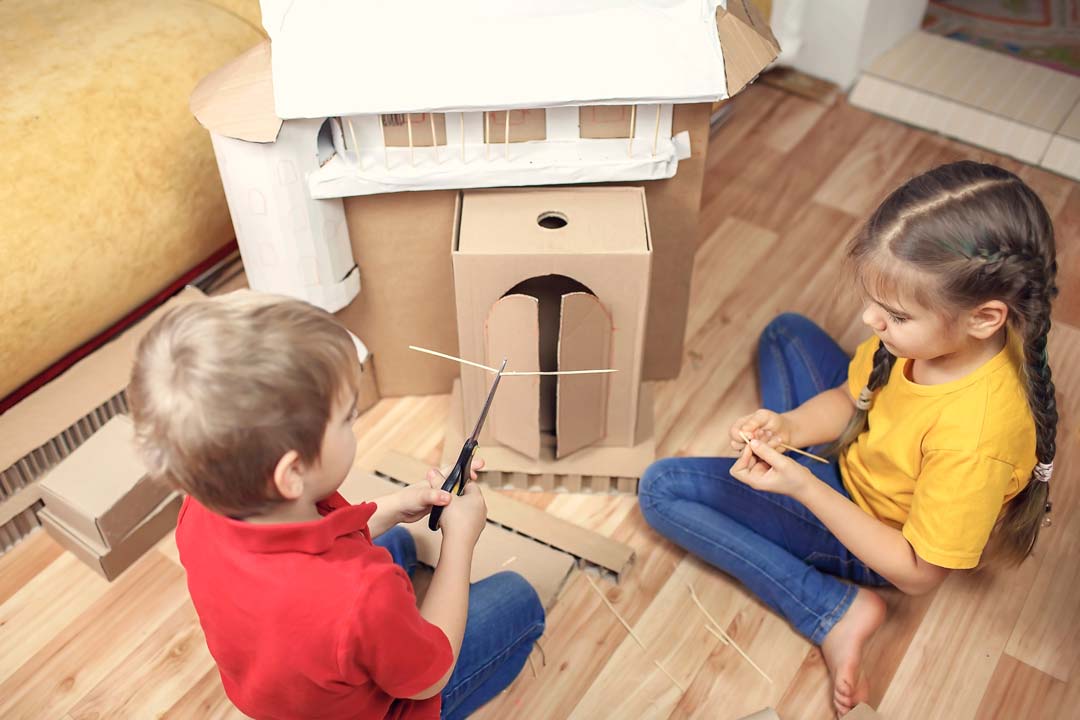
Where did Loose Parts Play originate?
The theory of Loose Parts Play was developed by a UK architect, Simon Nicholson in 1972. He believed that loose parts, materials that can be moved around, designed, redesigned, and tinkered with, create infinitely more opportunities for creative engagement than static materials and environments. Nicholson refined upon the play-based learning idea espoused by earlier researchers. Play-based learning using loose parts is not a new notion and was expressed more broadly by psychologist Lev Vygotsky (1896 – 1934). Vygotsky believed that “play is a vehicle for children to make meaning of their world”. Indeed, Albert Einstein (1879 – 1955) also stated that “Play is the highest form of research”. Developmental theory (Piaget, 1963) emphasised the need for the child to manipulate his or her environment, to experiment and to interact with materials to learn. Nicholson’s beliefs also support Malaguzzi in that creativity is not for the gifted few; that all children are born as creative beings, curious about the world and keen to experiment and discover new things. The idea of child-led play-based learning has existed for many years and its value in learning is recognised by researchers and educators. The loose parts play theory is an extension of this.
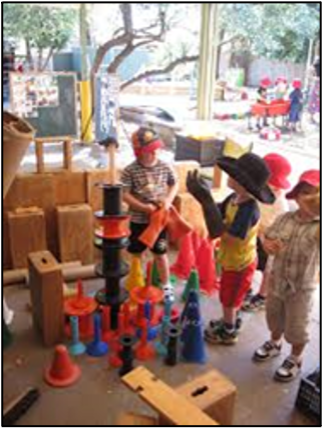
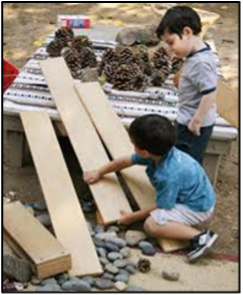
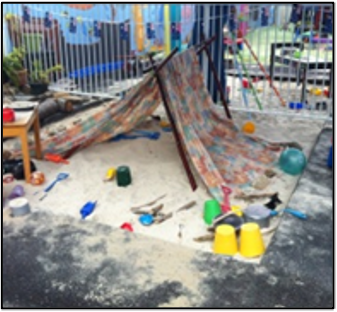
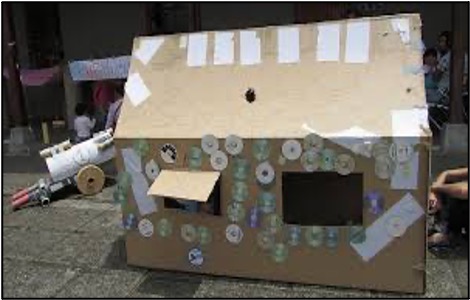
What are the benefits of loose parts play and does it link to the NQF?
Loose parts play offers children endless variation in open-ended play, thinking, and possibilities and is the original play-based learning. Most of us recall when we made cubby houses out of scraps of material, boxes, old furniture, and pieces of wood or played with found objects, repurposing them into something of our own design and vision. Playing with loose parts provides children with opportunities to plan, draw and design (literacy in action), question, explore, co-operate, and improve teamwork. Children develop resilience and determination as they work to identify solutions to the many questions raised during the process. These important life skills align neatly with the requirements of the NQF quality areas 1,2,3,5 and 6, with emphasis on quality area 3.
Loose parts play offers the following benefits to the curriculum:
- Extending indoors/outdoors – almost anything for indoors can be adapted for outdoors
- Maths concepts and skills – concepts such as volume, measurement, counting, sequencing, one-one correspondence, scale, perspective, large, small, positional terms such as under, over, on top, beside
- Scientific concepts – experimentation, real tools, inclines, windmills, chimes
- Opportunities to express joyfulness and just have fun
When do we facilitate it?
The beauty of loose parts play is that it can happen anywhere. Smaller item loose parts play is fabulous for indoors where space may be at a premium, but beware, many a classroom has been taken over by tunnel systems and other wonderful constructions. Outdoors, playing with loose parts allows children to extend their thinking without impacting on others’ play. Loose parts play is so flexible it easily incorporates natural and manufactured items.
There are no specific set of directions for engaging in loose parts play. It encourages children to exercise as they lift, move and stack; to engage in dramatic play while they make cubbies; organise, plan, and create new structures (construction and manipulative play). It encourages cooperative play as children access items that may be too heavy for one child to manage; reinforces games with rules. Children can engage with the same materials according to their developmental readiness; toddlers in parallel play and pre-schoolers in cooperative play.
What are teacher’s and educator’s roles?
The teacher’s role is to skillfully guide and engage with children when needed, to facilitate exploration with materials, provide opportunities to try new skills or revisit old ones, and offer positive support as children learn and create. Teaching will be intentional as educators step into and out of each play experience, offering suggestions or helping children by encouraging them to question and resolve challenges. Skillful adult guidance and support are key to the success of loose parts play. Educators must be present in the moment, able to think about what they are observing and what it means for children, so they can interpret and support learning that occurs in appropriate ways. Educators must be thoughtful, purposeful, and intentional as they support children through the creative process. Educators will also offer provocations from time to time and observe where children’s thinking takes them.
Educators:
- Ask children for their ideas on loose parts and what they would like to include (QA 1, 3)
- Assess risks to identify any potential safety concerns, consider the age groups at play, and if parts may be too small, too large, or heavy. (QA 1, 2, 7)
- Involve families in decisions and encourage contributions of appropriate items for loose parts play (QA 6)
- Promote strong, positive relationships between children as they work collaboratively during play (QA 5)
How do we resource loose parts play?
Loose parts play is very inexpensive, as many of the materials may be sourced by asking families and community groups for discarded items, or through second-hand or recycle stores. The resource dollar extends further when sourcing items for loose parts play.
Services have told us, tongue in cheek, that loose parts play has two disadvantages. The first is that almost anything can be repurposed and is useful, so it is very hard to throw anything away. Second, finding storage space for all the wonderful ‘potential’ you acquire can be difficult as so much is freely available. How can we go past a toaster, alarm clock or old radio to pull part, see how they work, then perhaps reconstruct, or repurpose into something entirely different? Such items are wonderful for experimentation and investigation.
Collections for loose parts play
Collect anything for children to use, natural, manufactured, or seasonal items. The following list is a small indicator of what you might gather:
Stones, stumps, sand, gravel, twigs, logs, large branches, leaves, pipes, pebbles, cardboard boxes and tubes, wood, pallets, balls, buckets, baskets, crates, logs, rope, tyres, boxes, shells, seedpods, wool, any craft material at hand, sheets, fabric pieces, old clocks, toasters, kettles, garden pots, building materials, chain, wooden reels, containers, canvas, hoops, tools.
Some items may be location/seasonal specific such as sea shells, hay bales, drift wood, native flora, and fauna. These items help children to learn about the changing seasons and times of year.
With loose parts play, the possibilities are only limited by our imaginations. Who knows where our loose parts play adventures will take us? It is an exciting mystery tour of fun and learning.
THE TOP 5 TOYS. . . according to “Geek Dad” from Wire.com.
- Coming in at number 5 is Dirt – the humble but great leveller
- Number 4 is Cardboard Tube, with fabulously flexible String at number 3.
- The amazing Box is number 2 with its marvellous variety of shapes and sizes.
- The big winner at number 1, however, is Stick – a truly classic and versatile toy. Imagine the marvels that can be created from the top 5.
CONTACT ONE OF OUR CENTRES
Out & About Care and Education
2 Newspaper Place
Maroochydore Q 4558
newspaperpl@outandabout.net.au
07 5413 8099
CONTACT NEWSPAPER PL
Out & About Care and Education
30 Dalton Drive
Maroochydore Q 4558
daltondr@outandabout.net.au
07 5479 1411
CONTACT DALTON DR
Out & About Care and Education
6 Mooloolah Rd
Mooloolah Valley Q 4553
mooloolah@outandabout.net.au
07 5356 9323

